For Native American artist Jeffrey Gibson, representing the United States at the Venice Biennale is complicated
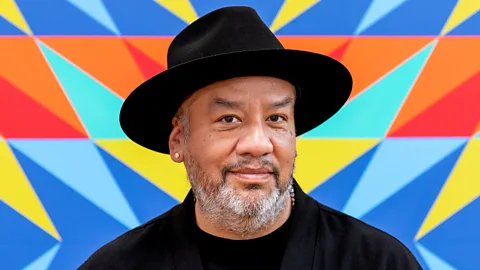 Brian Barlow
Brian BarlowThe Choctaw/Cherokee creative is the first Indigenous artist selected for a solo US show at the prestigious international art exhibition. Here he discusses his ambivalence about the honour.
It's complicated enough to represent one's country on a global stage as an artist, but that becomes ever more complex when that artist is Native American and that country is the United States. Queer Choctaw/Cherokee multimedia artist Jeffrey Gibson is grappling with notions of identity, belonging, and national pride as the first ever Indigenous artist selected by the US State Department to represent the country with a solo show at the Venice Biennale.
The 60th edition of the Biennale opens on 20 April and runs until 24 November. This year, the prestigious international art extravaganza's main exhibition is themed Stranieri Ovunque, meaning "Foreigners Everywhere". It takes its inspiration from a series of artworks of the same name by the Claire Fontaine collective, a feminist conceptual group known for its provocative neon signs that was founded by Fulvia Carnevale and James Thornhill in Paris in 2004. That concept also ripples out across the Biennale's nearly 90 national pavilions.
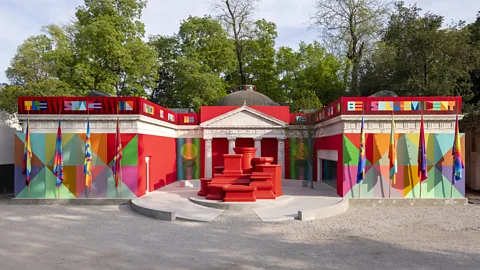 Timothy Schenck
Timothy Schenck"The expression has several meanings," explains 2024 Biennale director Adriano Pedrosa, who also serves as artistic director of the São Paulo Museum of Art. "First of all, that wherever you go and wherever you are, you will always encounter foreigners. Secondly, that no matter where you find yourself, you are always truly, and deep down inside, a foreigner."
The Biennale's first Latin American curator set out to make this year's event the most diverse ever, celebrating perspectives that have not historically been amplified in high-profile art spaces – including Indigenous worldviews. (The main exhibition alone features an unprecedented 331 artists who have ties to nearly 70 countries, with a focus on the Global South.)
It's fitting then that Gibson feels a sense of ambivalence about representing a nation with a long history of making its Native peoples feel like foreigners on their own ancestral homelands. But that idea has also been a driving force for the 52-year-old New Yorker as he has prepared his Biennale presentation.
"When I visited the pavilion a year ago, I asked myself, 'How is it that I can represent the United States, with all of its complicated and traumatic histories toward Native people?'" he recalls. "I don't think one person can truly represent an entire country. But in the best case, you can represent as earnestly as possible your relationship to these layered ideas of nationhood, of country, of Americanism, of Indigeneity."
Excavating the complexities of the US
The acclaimed artist's exhibition, "the space in which to place me", brings that complicated concept of intertwined identity to the forefront. The title comes from the poem "Ȟe Sápa" by renowned writer Layli Long Soldier (a member of the Oglala Lakota Nation), which speaks to the often limiting, externally imposed definitions of Indigeneity. Gibson aims to upend those restrictive beliefs and instead showcase the layered complexities of contemporary Native life in the United States.
And while he certainly feels a sense of pride having been selected for this high honour, does he also feel a sense of pride in his country?
"There are moments when I'm proud to be American, and there are also moments when I’m totally confounded," he says. "The promises of the United States can be invigorating in a way that many parts of the world have never experienced. But those promises have also been misinterpreted to empower some people and to disempower Native people. When the idea of 'nationalism' becomes divisive, it becomes problematic."
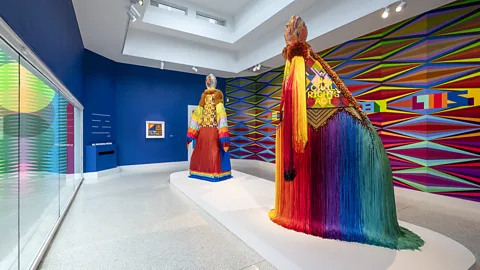 Timothy Schenck
Timothy SchenckGibson's Biennale presentation speaks to those truths with a wide range of media, from sculptures to paintings to videos, that project political statements in his signature kaleidoscopic colors. Vivid hand-painted murals feature text from US foundational documents, constitutional amendments (both ratified and not), legislation and speeches. A bust with long ribbons of hair speaks to the forced assimilation Native peoples faced at boarding schools, where children's hair was often cut short. A punching bag with intricate beadwork spelling out "We Hold These Truths to Be Self-Evident" (a notable line from the US Declaration of Independence) holds court in the pavilion's rotunda, which has been painted red – a colour closely associated with the Missing and Murdered Indigenous Persons crisis.
"Within the pavilion, I reference a lot of moments where people have proposed real plans for real equities," he says. "The irony, of course, is that those plans have not been fulfilled, and we can speak very clearly about the trauma of not having them fulfilled. We're trying to find a space to heal from that."
More like this:
Gibson has been championing Indigenous expression for the past two decades, long before the modern-day celebration of Native cultures that we're seeing, with mainstream audiences taking unprecedented interest in shows and films like Reservation Dogs and Killers of the Flower Moon.
"That interest [in Native cultures] is long overdue, but I do feel like it's going to have sustaining power," he says. "If you had asked me even a couple years ago, I would have wondered if it was just a trend. But in the moment we're in right now, I think it's very promising."
Just as he can't represent all of America, Gibson can't represent all of Native America, given that Indigenous cultures are not a monolith. In the United States alone, there are 574 federally recognised tribes that comprise a wide variety of rich cultures and traditions. Instead, he can only represent himself – and his ancestors.
"My aesthetic has been cumulative from all the places I've lived in a brown-skinned, Indigenous-identified body," he says. "I'm the culmination of the voices of my ancestors, including my grandmothers, who made clothes, baskets, and jewellery; my grandfathers, who were Southern Baptist ministers; [and] my uncles, who continued practising traditional dancing and singing. I am that nexus point of all of those histories."
Indigenous perspectives haven't been showcased at the US Pavilion since 1932, when works by several Native artists – including painters Fred Kabotie and Ma Pe Wi – were included in a group exhibition highlighting the American West. But that presentation was more "ethnographic" in nature, explains Portland Art Museum Curator of Native American Art Kathleen Ash-Milby, who is a member of the Navajo Nation. Alongside SITE Santa Fe Executive Director Louis Grachos and independent art curator Abigail Winograd, she commissioned Gibson's work for the Biennale, becoming the first Native American curator to do so.
Native artists around the Biennale
Beyond the US Pavilion, Native viewpoints are well-represented at the Biennale. The central exhibition features the larger-than-life installation Takapau by the Mataaho Collective, made up of four Maori women. Several other national pavilions – most notably the Australian, Brazilian/Hãhãwpuá, and Timor-Leste spaces – exhibit artists expressing their unique experiences of Indigenous existence, resistance, and persistence. For Gibson, that representation matters.
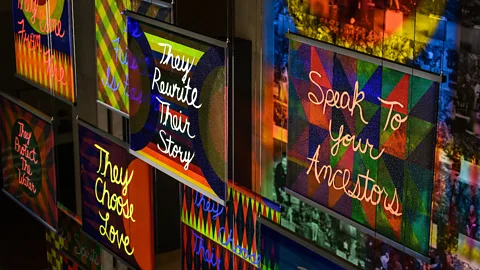 Portland Art Museum
Portland Art Museum"Native people have always been a part of the world; we just haven't always been discussed as having been a part of the world," he says. "For instance, very rarely do we talk about what was happening with Native people in 1750 [in parallel] with what was happening in [other places around the world] at that same time. I hope that by expressing this intersectionality of contemporary life that I'm allowing people to understand the complexity of their own narratives and their ancestors' narratives.”
In the United States, those personal narratives are inextricably interwoven with the nation's history, which, as many have suggested, has been whitewashed in an attempt to downplay the traumatic effects of colonialism on both Indigenous and Black peoples. Even today, tribal communities experience marked health disparities, outsized violence, shorter life expectancies, and disproportionate rates of poverty, addiction, and suicide. Those stark realities are part of the ever-evolving US experience.
"Throughout my lifetime, the idea of what 'American' means both in my own eyes and in the eyes of the world has changed and continues to change," says Gibson, who grew up living in the United Kingdom, Germany, and Korea. "Many of us come from so many different crossroads of race, heritage, culture, and tradition, and I'm in favour of that being explicitly present."
As is typically the case for Native individuals – who all too often bear the burden of teaching others about the atrocities tribal communities have faced – education is part of Gibson’s repertoire. To that end, he'll participate in several symposiums and seminars throughout the Biennale run, including a week-long Indigenous arts programme taking place in June at Ca’ Foscari University and presented in collaboration with the Institute of American Indian Arts.
With his evocative artwork at the Biennale and beyond, Gibson strives to spark complex conversations "where people aren't afraid to say where they're at with these ideas and don't feel as though they're going to be shut down – with the intention of arriving at a place where we can coexist".
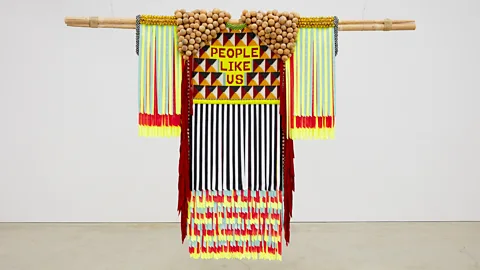 Sikkema Jenkins & Co/Roberts Projects/Stephen Friedman Gallery
Sikkema Jenkins & Co/Roberts Projects/Stephen Friedman GalleryBut above all, he wants to carve out a sustainable spot within the art world for Native perspectives – something he hasn't experienced during his decades-long career but sees on the horizon.
"Our children are experiencing the world through a lens that includes a very strong influence of Native creativity," he says. "As more Native artists emerge, I hope we can build a world of makers and creative thinkers that isn't guided by greed and wanting. Right now we exist in all of these hundreds of different tribal nations, but can we find a way to come together and have a collective voice?"
--
If you liked this story, sign up for The Essential List newsletter – a handpicked selection of features, videos and can't-miss news delivered to your inbox every Friday.
